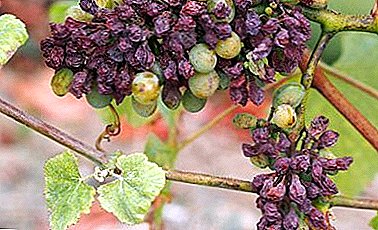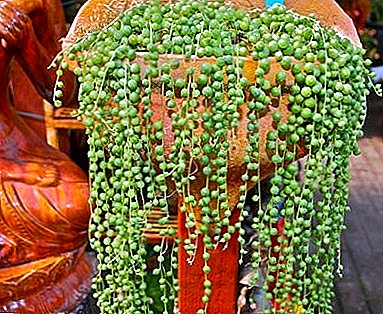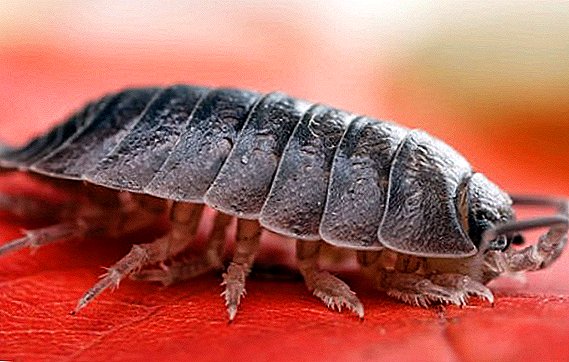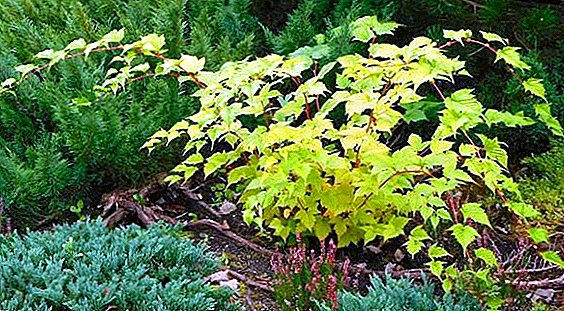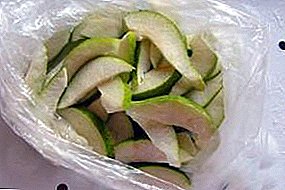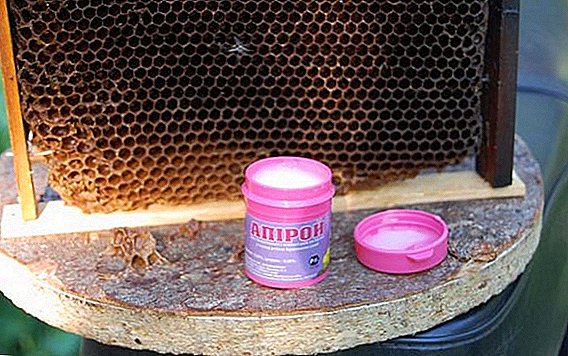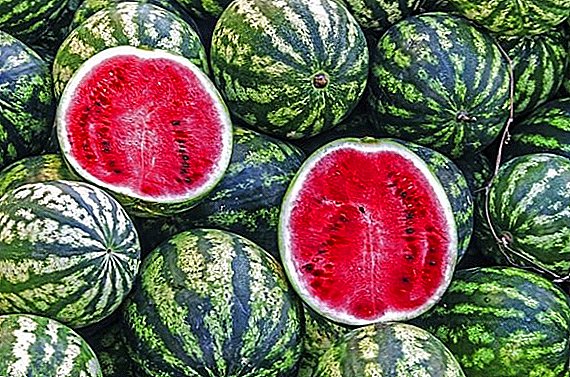 The fame of the variety of watermelons "Astrakhansky" spread not only the whole of Russia, but went far beyond its borders. Legendary this variety made high yields, excellent taste, keeping quality and transportability of berries. In addition, farmers do not hide the joy of plant simplicity. On the main advantages of the variety and the nuances of its cultivation in the household economy will be discussed further.
The fame of the variety of watermelons "Astrakhansky" spread not only the whole of Russia, but went far beyond its borders. Legendary this variety made high yields, excellent taste, keeping quality and transportability of berries. In addition, farmers do not hide the joy of plant simplicity. On the main advantages of the variety and the nuances of its cultivation in the household economy will be discussed further.
Description and characteristics of the variety
The authorship of the Astrakhan watermelon belongs to the well-known in the Russian Federation breeder and honored worker of science Konstantin Dyutin. The breeder’s dream was to create a berry with a perfectly even round shape and high-quality taste characteristics. This is exactly what this variety is. 
It would seem that the watermelon "Astrakhansky" by its external description is very close to its fellows. It has the same smooth skin with typical stripes. But, unlike other varieties, the berry is thick-skinned. On average, its weight ranges from 8 kg.
Learn more about the varieties of watermelon and what benefits it brings to the human body.
You can eat ripe fruits within 75-85 days after planting. When cutting the eye attracts fine-grained bright red flesh. With a long summer drought, an emptiness may form inside, but this fact does not affect the taste at all.
Another feature of the variety, which certainly causes joy among gardeners, is high resistance to pathogens fusarium, anthracnose and other diseases that affect melons. In the reviews the hostess noted that "Astrakhan" has properties to persist for about two months.
The variety is considered high-yielding.. With large-scale crops from 1 hectare, up to 120 tons of watermelon canceled in quality and taste can be collected.
Did you know? To check the watermelon for the presence of nitrates, you need to dip a small slice of pulp in the water. The reddened liquid indicates the presence of chemistry in the fetus, and the opacified, on the contrary, speaks of its purity.
How to grow seedlings
Many landowners believe that a good yield of melon can be given only in the southern regions. The Astrakhansky watermelon, the geography of cultivation of which is much wider, dispels these errors radically.
Farmers of middle latitudes, for whom late spring is typical, are more prone to seedling technology of cultivation of these berries. Some practice planting grains on seedlings immediately in open ground, while others use greenhouses for this. Consider the feature and effectiveness of both methods.
In the greenhouse
Growing seedlings of melons in many ways resembles cucumbers. Under greenhouse conditions, sowing of seeds is carried out in the period from the end of March to mid-April with reference to the lunar calendar. Land for planting should be neutral and enriched with nutrients. Cucumber mixtures can be used. 
To speed up the germination of grains, they must be held for 15 minutes in water heated to 50 degrees.  This event will contribute to the softening of the seed coat. Some gardeners resort to stratification of planting material.
This event will contribute to the softening of the seed coat. Some gardeners resort to stratification of planting material.
To do this, it is wrapped in a wet and well-pressed flap of fabric, then left for a week in the refrigerator. It is advisable to place the rolls somewhere close to the freezer.
Important! Before planting, watermelon seeds are placed for hardening for 8 hours on melting ice.
If desired, you can further process any growth promoters. When everything is ready, fill the plastic cups with the prepared substrate and deepen into them at the level of 4 cm several seeds. Then all containers are covered on top with polyethylene or the same container and removed in the heat. The optimum temperature regime of the greenhouse should be at the level of 25-26 ° С. 
When the first shoots appear, all the shelters need to be removed and look at the shoots. Loose immediately remove. It is also important to take care of good lighting. In a greenhouse, seedlings will grow no more than 35 days before the appearance of the first four leaves.
It will be useful for you to learn how to properly plant and grow watermelons in your area.
In the open ground
For the cultivation of watermelon seedlings directly on the garden need to prepare the soil with good drainage. Planting should be planned with a stable daytime air temperature of 14-16 ° С, when the earth warms up well and spring frosts are bypassed. As a rule, this is the end of May.
The seed wells are fertilized with humus, on which a 10 cm layer of soil is placed on top. It is important to take into account the width between the rows - ideally, they should be at least one and a half meters. A similar distance is made in the rows between the pits.
They are sown in the same way as in the greenhouse variant, in several grains, and as they germinate, the stems are sent in different directions. Sowing, before the first two pairs of leaves appear on it, be sure to cover with agrofiber.
Did you know? Seeds of watermelons were found in the tomb of Tutankhamen. The ancients believed that in the other world berries will replace the dead food.
Where is the best place to plant "Astrakhan" watermelon
Place for bahchi should be chosen very carefully. "Astrakhan" watermelon loves heat and moisture, so it is desirable to protect the site from drafts and winds. 
The soil on it is desirable light, black and not sour. Special attention should be paid to the predecessors..
It is better to sow melon crops after potatoes, corn and legumes. Watermelon sprouts will develop badly after melons, cucumbers, pumpkins, cabbage.
The process of transplanting seedlings in open ground
30-day-old seedlings are transplanted to the garden in the open ground. 
It is important that before this moment the earth warms up well, and the daytime temperature is around 18 ° C. For the "Astrakhan" variety, the optimal planting pattern is 90 × 50 cm.
The process of transplantation begins with the preparation of pits, at the bottom of which liquid fertilizers are poured onto the bottom. They are prepared from 30 g of ammonium sulfate, 20 g of potassium salt and 40 g of superphosphate. The mixture needs to be dissolved in 2 liters of water. Alternatively, you can use the solution from the infusion of chicken manure or mullein.
Radish, tomato, leek, pea, curling beans or spinach can be good neighbors for watermelons.
Then all sprinkled with earth and add a handful of wood ash on top, sprinkle again. When the bottom of the hole is prepared, it is watered with heated water. At each recess will need approximately one liter of fluid. After the manipulations are done, the cup is carefully cut or the bottom of the cup is pressed down in order to extract the earthen clod with the stem.
Then it is deepened in such a way that the ground level reaches the cotyledon leaves. The final stage of planting is mulch beds. For these purposes, use sand or humus. This layer contributes to moisture retention and warms the soil.
Important! On watermelons a layer of mulch should be no thinner than 5 cm.
Care rules
Care for the "Astrakhan" watermelon does not portend anything new. Experienced gardeners know that they need to provide enough moisture and heat to get the melon crop. Consider the main subtleties of cultivation of culture.
Temperature and lighting
For the full development of watermelon need a lot of light.. In the shade shoots will be weak and fragile. In addition, the harvest from such a bed should not be expected. In the fibers of watermelon photosynthesis processes are hampered even in cloudy weather. Therefore, when summer does not indulge in sunny, warm days, the berries are a little dry and unsweetened.
During the greenhouse cultivation of these crops, it is necessary to use additional lighting. The temperature regime is also important for the plant.
Ideally, for good growing season its limits range from 30 to 40 ° C. In cold weather, growth stops, and stable + 10-15 ° C adversely affect watermelons.
Important! When choosing a ripe watermelon, pay attention to the condition of the skin. Y "Astrakhan" varieties do not have matte coating, the sun's rays always cast clear glare.
Humidity and watering
Watermelon wattle have a strong root system, which extends in depth and in breadth by 30 cm. The culture tolerates drought well, because the roots suck in nutrients from the depths along with moisture. But to abuse the stamina of the plant is not worth it. For full development it is very important to get plenty of water. It is advisable to conduct the humidification daily with warm, settled water..
Experienced farmers reduce the amount of watering to once every two days, when the fruiting period begins. This nuance contributes to the fact that the berries begin to ripen faster.
Soil fertilizer
In addition to fertilizing seedlings during cultivation and planting, watermelon requires them to be repeated every two weeks. It is better to alternate organic and mineral complex fertilizers. When using chicken manure and mullein, be sure to wait until the solution begins to ferment.
If you do not comply with this recommendation, the berries will contain a lot of nitrates.
Did you know? Translated from the Turkic watermelon means "donkey cucumber".
When to harvest and how to store crops
The collection of "Astrakhan" watermelons always falls on August and September. The ripeness of the berries is determined by the outgoing ringing when tapping and the dry stalk. Harvesting is important with maximum caution, otherwise even the slightest mechanical damage will not allow the berries to be well preserved. All fruits must be complete, without abrasions and blows, cracks.
In storage the berries will be comfortable at a temperature of + 1-3 ° C and humidity at 80%. You also need time to take care of ventilation in the cellar. "Astrakhan" grade has a good keeping quality. Experienced housewives manage to preserve its fruits safely and securely until the New Year.
The secret of this lies in the microflora in which watermelon is placed. It is covered with a thick layer of dry forest moss or thickly coated with paraffin, wax. Some summer residents share their experience of successfully storing fruits in a keg of ash.
As a result of all the worries, you will get a unique melon berry, which is not only delicious, but also a useful delicacy.


